2007 Mercury Mariner Hybrid tow
[x] Cancel search: towPage 2 of 336

Seating and Safety Restraints 119
Seating 119
Safety restraints 127
Airbags 141
Child restraints 156
Tires, Wheels and Loading 168
Tire Information 170
Tire Inflation 172
Tire Pressure Monitoring System (TPMS) 184
Vehicle loading 188
Trailer towing 194
Recreational towing 198
Driving 199
Starting 199
Brakes 202
Transmission operation 206
Roadside Emergencies 218
Getting roadside assistance 218
Hazard flasher switch 219
Fuel pump/High voltage shut-off switches 220
Fuses and relays 221
Changing tires 228
Lug Nut Torque 239
Jump starting 240
Wrecker towing 247
Customer Assistance 248
Reporting safety defects (U.S. only) 254
Cleaning 255
Table of Contents
2
2007 Mariner Hybrid(mhv)
Owners Guide (post-2002-fmt)
USA(fus)
Page 5 of 336

SAFETY AND ENVIRONMENT PROTECTION
Warning symbols in this guide
How can you reduce the risk of personal injury to yourself or others? In
this guide, answers to such questions are contained in comments
highlighted by the warning triangle symbol. These comments should be
read and observed.
Warning symbols on your vehicle
When you see this symbol, it is
imperative that you consult the
relevant section of this guide before
touching or attempting adjustment
of any kind.
Protecting the environment
We must all play our part in
protecting the environment. Correct
vehicle usage and the authorized
disposal of waste, cleaning and
lubrication materials are significant
steps towards this aim. Information in this respect is highlighted in this
guide with the tree symbol.
BREAKING-IN YOUR VEHICLE
Your vehicle does not need an extensive break-in. Try not to drive
continuously at the same speed for the first 1,000 miles (1,600 km) of
new vehicle operation. Vary your speed frequently in order to give the
moving parts a chance to break in.
Drive your new vehicle at least 500 miles (800 km) before towing a
trailer. For more detailed information about towing a trailer, refer to
Trailer towingin theTires, Wheels and Loadingchapter.
Do not add friction modifier compounds or special break-in oils since
these additives may prevent piston ring seating. SeeEngine oilin the
Maintenance and Specificationschapter for more information on oil
usage.
NORMAL VEHICLE OPERATION
Your Mariner Hybrid has unique qualities which cause it to operate
differently than a typical vehicle.
2007 Mariner Hybrid(mhv)
Owners Guide (post-2002-fmt)
USA(fus)
Introduction
5
Page 6 of 336

Starting the vehicle
•The engine will start and run when you first turn the ignition key to
the start position.
•The engine cannot be started in the N (Neutral) position.
•Depending upon temperature and the high voltage battery’s state of
charge, the engine may shut off shortly after starting the vehicle; this
is a normal condition and you do not need to restart the vehicle. The
Ready Indicator Light in the instrument cluster will illuminate to
indicate the vehicle is running. For more Ready Indicator Light
information, refer toWarning lights and chimesin theInstrument
Clusterchapter.
DRIVING THE VEHICLE
Starting Out:
Under normal operation with the vehicle at operating temperature, the
engine will start automatically as you accelerate. Sometimes the engine
will start immediately as you begin moving, while other times the vehicle
will obtain a speed of up to 25 mph (40 km/h) before the engine starts.
You may hear and feel the engine starting as you transition from
electrical to hybrid (gas engine on) operation. This is a normal condition.
These are some of the conditions that may cause engine start-up:
•High voltage battery re-charge is required.
•Driver acceleration demands exceed electric motor capability.
•Outside air temperature is overly hot or cold.
•Certain climate system modes of operation.
•If you are starting up hill or accelerating quickly, the engine will start
immediately as operating conditions require additional power.
Note:If the high voltage battery is very cold or very hot, the engine may
operate more than under normal conditions, and vehicle performance
may be temporarily reduced. This is a normal condition.
Transmission operation
•Your vehicle does not shift like a conventional vehicle. You may feel
transitions between the various operating modes of the hybrid system,
but no actual shifting occurs. For more information about transmission
operation, refer toUnderstanding the gearshift positions of the
electronically-controlled Continuously Variable Transaxle (eCVT)
in theDrivingchapter.
2007 Mariner Hybrid(mhv)
Owners Guide (post-2002-fmt)
USA(fus)
Introduction
6
Page 29 of 336
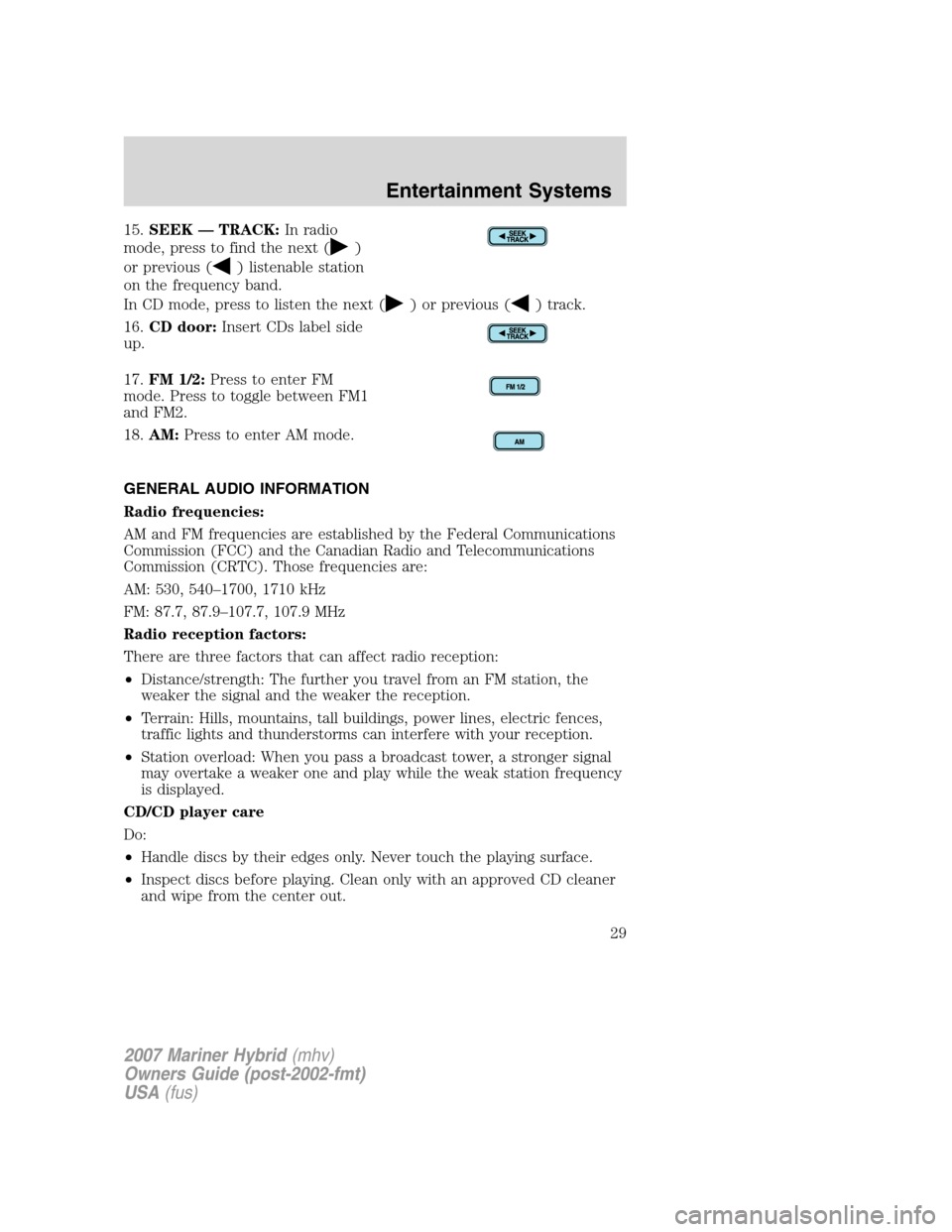
15.SEEK — TRACK:In radio
mode, press to find the next (
)
or previous (
) listenable station
on the frequency band.
In CD mode, press to listen the next (
) or previous () track.
16.CD door:Insert CDs label side
up.
17.FM 1/2:Press to enter FM
mode. Press to toggle between FM1
and FM2.
18.AM:Press to enter AM mode.
GENERAL AUDIO INFORMATION
Radio frequencies:
AM and FM frequencies are established by the Federal Communications
Commission (FCC) and the Canadian Radio and Telecommunications
Commission (CRTC). Those frequencies are:
AM: 530, 540–1700, 1710 kHz
FM: 87.7, 87.9–107.7, 107.9 MHz
Radio reception factors:
There are three factors that can affect radio reception:
•Distance/strength: The further you travel from an FM station, the
weaker the signal and the weaker the reception.
•Terrain: Hills, mountains, tall buildings, power lines, electric fences,
traffic lights and thunderstorms can interfere with your reception.
•Station overload: When you pass a broadcast tower, a stronger signal
may overtake a weaker one and play while the weak station frequency
is displayed.
CD/CD player care
Do:
•Handle discs by their edges only. Never touch the playing surface.
•Inspect discs before playing. Clean only with an approved CD cleaner
and wipe from the center out.
2007 Mariner Hybrid(mhv)
Owners Guide (post-2002-fmt)
USA(fus)
Entertainment Systems
29
Page 43 of 336
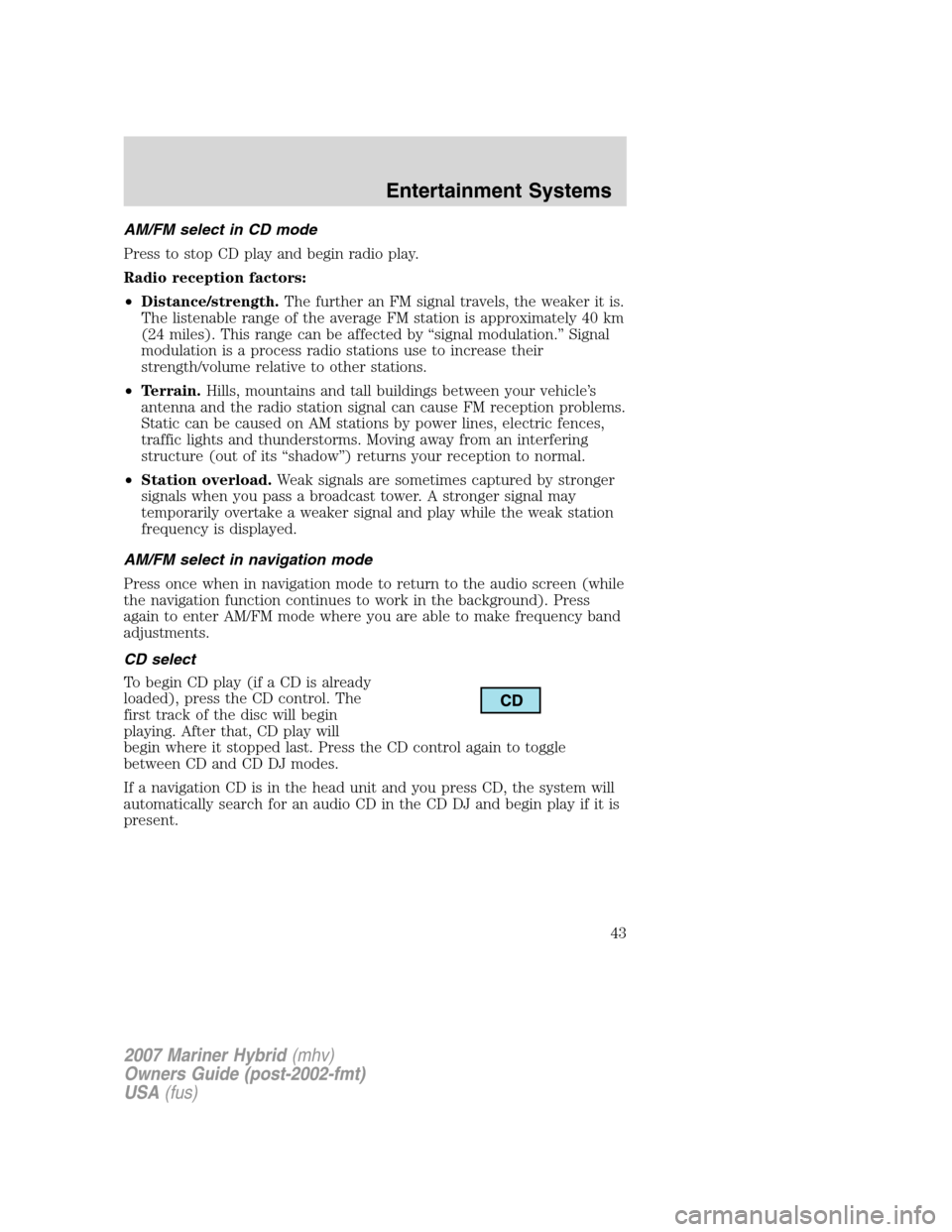
AM/FM select in CD mode
Press to stop CD play and begin radio play.
Radio reception factors:
•Distance/strength.The further an FM signal travels, the weaker it is.
The listenable range of the average FM station is approximately 40 km
(24 miles). This range can be affected by “signal modulation.” Signal
modulation is a process radio stations use to increase their
strength/volume relative to other stations.
•Terrain.Hills, mountains and tall buildings between your vehicle’s
antenna and the radio station signal can cause FM reception problems.
Static can be caused on AM stations by power lines, electric fences,
traffic lights and thunderstorms. Moving away from an interfering
structure (out of its “shadow”) returns your reception to normal.
•Station overload.Weak signals are sometimes captured by stronger
signals when you pass a broadcast tower. A stronger signal may
temporarily overtake a weaker signal and play while the weak station
frequency is displayed.
AM/FM select in navigation mode
Press once when in navigation mode to return to the audio screen (while
the navigation function continues to work in the background). Press
again to enter AM/FM mode where you are able to make frequency band
adjustments.
CD select
To begin CD play (if a CD is already
loaded), press the CD control. The
first track of the disc will begin
playing. After that, CD play will
begin where it stopped last. Press the CD control again to toggle
between CD and CD DJ modes.
If a navigation CD is in the head unit and you press CD, the system will
automatically search for an audio CD in the CD DJ and begin play if it is
present.
2007 Mariner Hybrid(mhv)
Owners Guide (post-2002-fmt)
USA(fus)
Entertainment Systems
43
Page 57 of 336
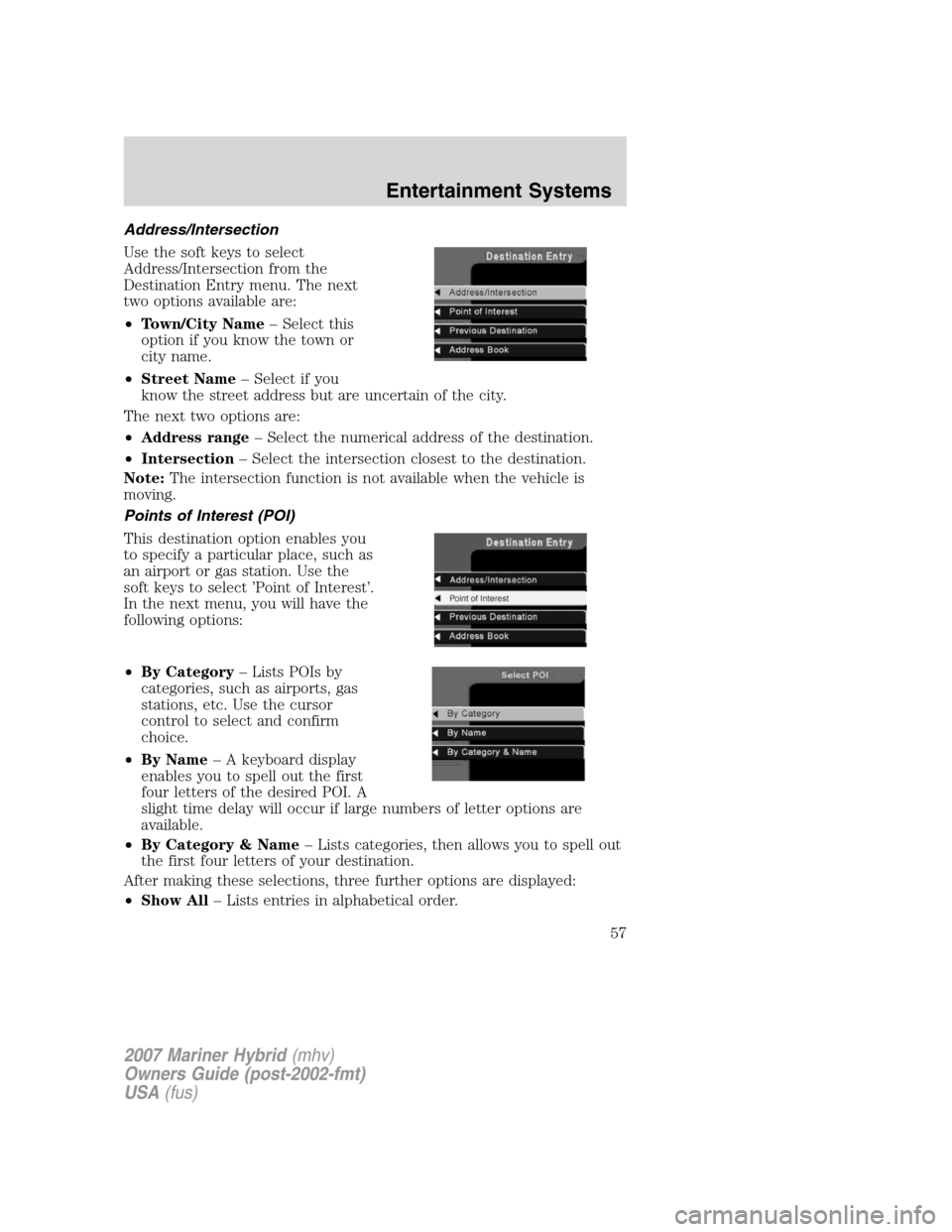
Address/Intersection
Use the soft keys to select
Address/Intersection from the
Destination Entry menu. The next
two options available are:
•Town/City Name– Select this
option if you know the town or
city name.
•Street Name– Select if you
know the street address but are uncertain of the city.
The next two options are:
•Address range– Select the numerical address of the destination.
•Intersection– Select the intersection closest to the destination.
Note:The intersection function is not available when the vehicle is
moving.
Points of Interest (POI)
This destination option enables you
to specify a particular place, such as
an airport or gas station. Use the
soft keys to select ’Point of Interest’.
In the next menu, you will have the
following options:
•By Category– Lists POIs by
categories, such as airports, gas
stations, etc. Use the cursor
control to select and confirm
choice.
•By Name– A keyboard display
enables you to spell out the first
four letters of the desired POI. A
slight time delay will occur if large numbers of letter options are
available.
•By Category & Name– Lists categories, then allows you to spell out
the first four letters of your destination.
After making these selections, three further options are displayed:
•Show All– Lists entries in alphabetical order.
2007 Mariner Hybrid(mhv)
Owners Guide (post-2002-fmt)
USA(fus)
Entertainment Systems
57
Page 58 of 336
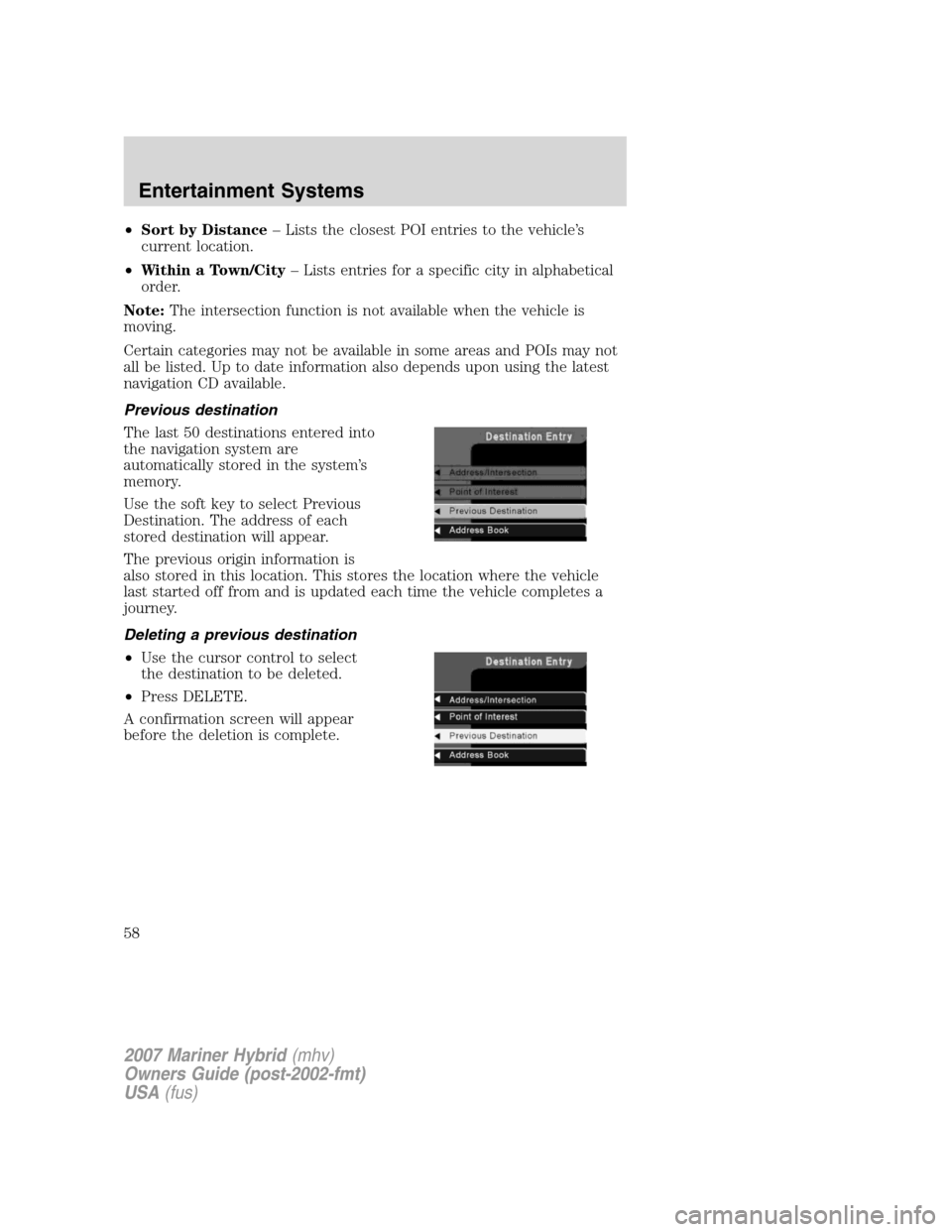
•Sort by Distance– Lists the closest POI entries to the vehicle’s
current location.
•Within a Town/City– Lists entries for a specific city in alphabetical
order.
Note:The intersection function is not available when the vehicle is
moving.
Certain categories may not be available in some areas and POIs may not
all be listed. Up to date information also depends upon using the latest
navigation CD available.
Previous destination
The last 50 destinations entered into
the navigation system are
automatically stored in the system’s
memory.
Use the soft key to select Previous
Destination. The address of each
stored destination will appear.
The previous origin information is
also stored in this location. This stores the location where the vehicle
last started off from and is updated each time the vehicle completes a
journey.
Deleting a previous destination
•Use the cursor control to select
the destination to be deleted.
•Press DELETE.
A confirmation screen will appear
before the deletion is complete.
2007 Mariner Hybrid(mhv)
Owners Guide (post-2002-fmt)
USA(fus)
Entertainment Systems
58
Page 59 of 336
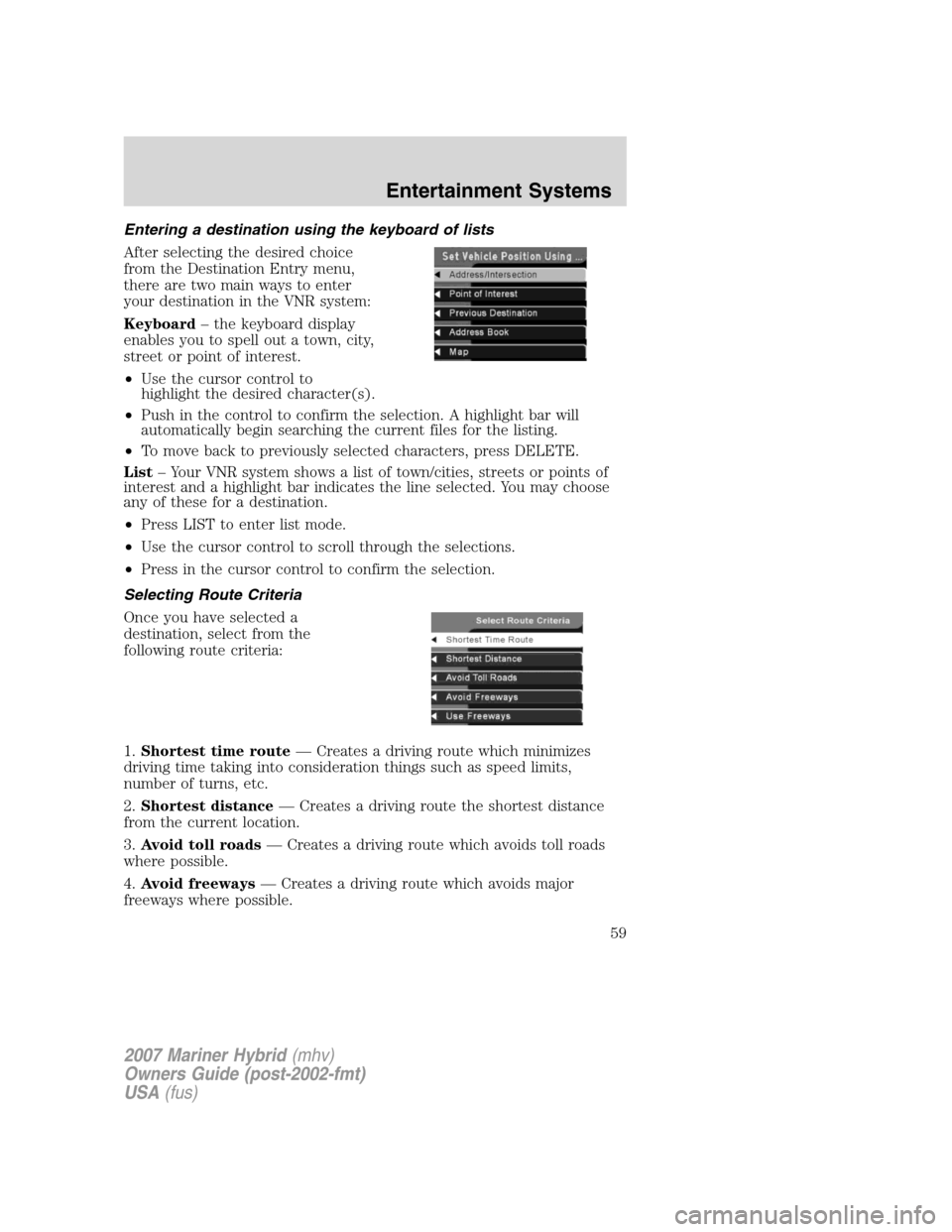
Entering a destination using the keyboard of lists
After selecting the desired choice
from the Destination Entry menu,
there are two main ways to enter
your destination in the VNR system:
Keyboard– the keyboard display
enables you to spell out a town, city,
street or point of interest.
•Use the cursor control to
highlight the desired character(s).
•Push in the control to confirm the selection. A highlight bar will
automatically begin searching the current files for the listing.
•To move back to previously selected characters, press DELETE.
List– Your VNR system shows a list of town/cities, streets or points of
interest and a highlight bar indicates the line selected. You may choose
any of these for a destination.
•Press LIST to enter list mode.
•Use the cursor control to scroll through the selections.
•Press in the cursor control to confirm the selection.
Selecting Route Criteria
Once you have selected a
destination, select from the
following route criteria:
1.Shortest time route— Creates a driving route which minimizes
driving time taking into consideration things such as speed limits,
number of turns, etc.
2.Shortest distance— Creates a driving route the shortest distance
from the current location.
3.Avoid toll roads— Creates a driving route which avoids toll roads
where possible.
4.Avoid freeways— Creates a driving route which avoids major
freeways where possible.
2007 Mariner Hybrid(mhv)
Owners Guide (post-2002-fmt)
USA(fus)
Entertainment Systems
59